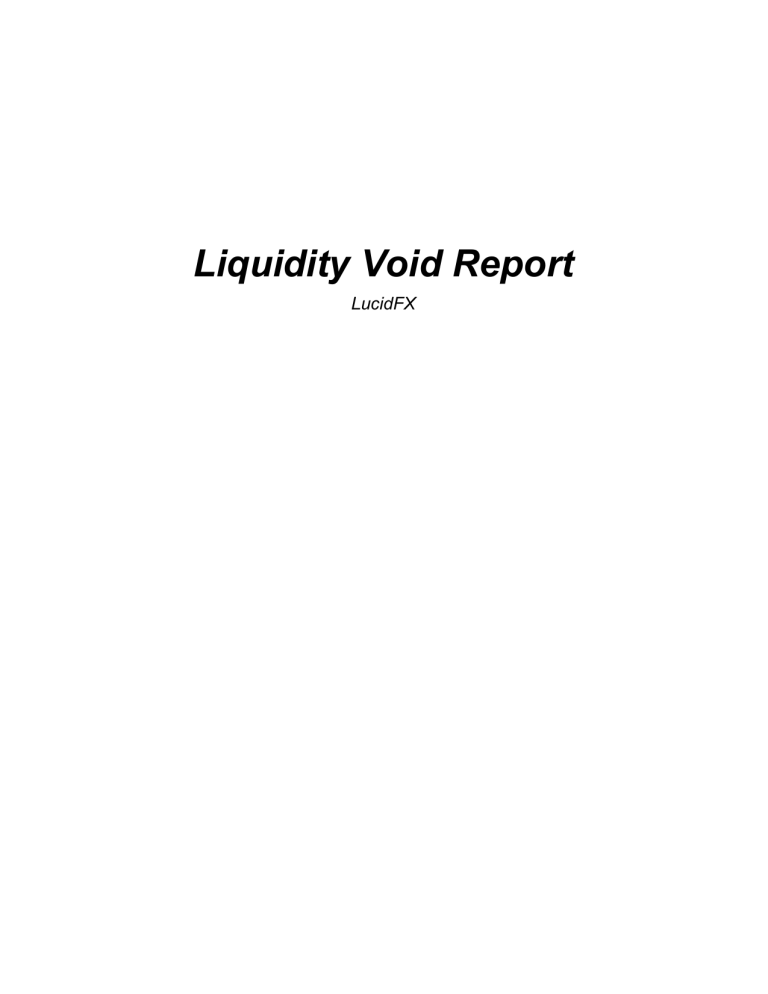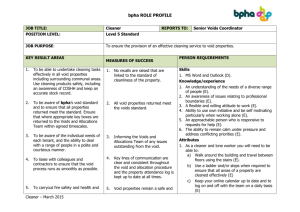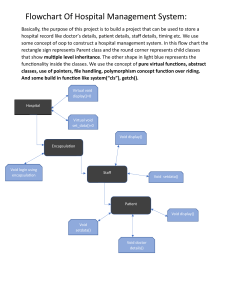
Liquidity Void Report LucidFX Introduction Over my past three years of trading I’ve yet to find a concept as reliable and consistent as ‘liquidity voids’. The concept is simple but your ability to apply and profit from it will correlate directly to your ability to practice and experience the different variations of each liquidity void. Liquidity voids are not the holy grail of trading but it’s the closest thing to it (that I’ve found). After two years of practicing, identifying and trading these liquidity voids I can say with confidence that these voids can and will make you an incredible amount of money. It will not come right away, you won’t be able to read this report and instantly make money off them but you will be able to start understanding and identifying these voids in a real time environment. If you haven’t set up some type of journal to log your observations I’d strongly advise to do so before reading further. This will be key to the identification of liquidity voids. I’d also appreciate it if you would keep what you learn in this report on the down low, share bits and pieces but don’t give away the whole pie … this report is the whole pie. Liquidity Void Definition: A liquidity void is an impulsive move away from a level that creates 1-3 big bodied candles whose bodies have yet to be filled in by other candles. This is considered inefficient price action, price must fill in these bodies before resuming in the direction of the big bodied candles. Example on XBTUSD 4-hour chart: Liquidity Void Example #2: Example #3: Liquidity Void Takeaways: There are a few aspects to a liquidity void and its fill that we need to pay attention to. 1. Creation of the void ○ The aggressive expansion that creates the void should come from an area of consolidation. ○ Void creations are versatile but ideally, the void gets created in 1-3 big bodied H4 candles. ○ The void should be above / below an area of accumulation or consolidation. That allows the void fill to tap into that accumulation while filling the void. 2. Liquidity generation within the void ○ Notice how price prints clean H4 highs within the void that DON’T completely fill the void. ○ Identification of these swing points within the void is the key to forming setups. ○ Either trade towards the void & liquidity or patiently wait for an AGGRESSIVE raid of the swing points into the liquidity void. We will talk more about this later. 3. The fill of the void ○ The price swing that fills the void serves two purposes. The first is obviously, filling the void and tapping into the area of accumulation that the void came from. The second is executing the stop orders resting above / below our swing points that price generated earlier (refer to above examples) ○ The move that fills the void should be incredibly impulsive, it should create a void of its own within filling, allowing price to return in the direction of the void. ○ Entering upon an aggressive void fill will take a lot of practice, you must train your mind to enter against strong moves as long as they are filling a larger void. 4. Where we consider a void ‘filled’ ○ This is the most difficult to put into words due to the different candle structure on lower time frames. ○ It is my experience that the 4-Hour chart works best for identifying fill points, we will have an in depth section discussing this but for now, find the most recent opposite colored candle leading the creation of the void. ○ Daily candles are efficient as well, if you are seeing one on a lower time frame print your fill point higher / lower than you would on a HTF chart. Types of Liquidity Voids Trend reversal liquidity voids: These liquidity voids change the direction of an intermediate to long term trend. There will be an extended amount of price action above / below these types of voids. The market will wait to fill this void until all intermediate term liquidity voids on the opposite side are filled. The constant creation and fills of voids opposite of this original void will create an intermediate term trend, once the master void at the bottom / top of the range is filled price will expand incredibly aggressively reversing the intermediate term trend. Trend continuation liquidity voids: These voids are generally printed on the lower time frames (m15-h1). There will usually be a larger liquidity void in the direction of the trend that price is attracted to on the higher time frames. The hook and ladder will be especially useful when identifying these types of liquidity voids. You will usually see a scam wick fill these types of voids. Fake out / neutralization void: These voids often neutralize liquidity above highs or below lows before reversing. They trick traders into thinking price is expanding towards new lows/highs when in reality price is neutralizing liquidity above/below swing points. We look for these voids to be ignored after manipulating our designated level(s). These types of voids will often mix and match with the other types. Types of Liquidity Voids Trend Reversal Liquidity Void: Types of Liquidity Voids Trend Continuation: Types of Liquidity Voids Fake Out Void: Void Fills Forecasting: There will be an experience factor when identifying / predicting void fills, there is no way around this. However, there is a systematic approach to predicting when price will fill a void. First, we must review the two different types of void fills; wicked fills and body fills. Wicked Fills: The liquidity void is filled by an aggressive wick before reversing. Body Fills: The liquidity void is filled by a candle body before reversing. Once a liquidity void is formed, allow price to pause and consolidate, this consolidation will generate liquidity. The opportunity comes once the liquidity is manipulated, this is where you enter your position. Void creation → liquidity generation → manipulation → void fill → reversal The idea is to catch the reversal after the void is efficiently filled. So, when is a void filled? This will be easier explained with chart examples. Remember, void fills should be aggressive. If you see a fill that lacks aggression be very hesitant on forming a reversal setup. Again, it will not be easy entering against an aggressive move but it will come as your identification skill increases. Void Fills An effective liquidity void will always have liquidity generated above / below its fill point. It is important to always make sure there is some form of consolidation or liquidity generation by your designated void. If there is no liquidity within the void then it will lose its significance and won’t be filled. As you start to see a void form pause and let a structure form within the void. This structure should generate our needed liquidity and tighten the void, this tightened / shrunk void is what I call the ‘sweet spot’. The sweet spot will provide excellent entries and invalidation levels allowing a much more beneficial R:R. It is also important to take the time frame into consideration. As the timeframes change, so do the price structures and liquidity voids. I like to use the 4-Hour chart as my “go to” time frame for voids. There will be different strategies we implement with the changing timeframes, we will talk more about this later. Not every void will be filled. Use what we’ve talked about earlier in this report to identify high probability liquidity voids and add the MLR strategy as extra confluence. The best way Let’s look at some examples: Do NOT try and force liquidity voids, look for high quality voids with liquidity generated within them and stay PATIENT. Void Fills Trading Strategies Now for the interesting part, how do we translate this information into a profitable trading strategy? I have three different strategies I implement depending on the market environment. I have a LTF scalping strategy, a HTF swing strategy and a ‘trading into the void’ strategy. I will give you a brief overview of each of these strategies then provide you with examples as I believe that is the best way to program them into your brain. The Scalping Strategy: This strategy is incredibly versatile and works well in just about any market environment. I typically implement it when we are chopping on the higher time frames. With this strategy we must stay disciplined and be in and out of the market as quickly as possible due to the fact that it is a scalping strategy. I use the m5-m15 timeframes for this strategy, we are basically doing everything I’ve shown you just on a much lower timeframe with lower intervals and much more pressure which is why it is important to be in and out as quickly as possible. Lower time frames will provide more liquidity voids making it a bit more difficult to identify the correct void to use, pay attention to the examples we go over and re-read the report if needed. Rules: ● Give yourself a weekly trade limit with this strategy ● Trade in the direction of the trend ● Liquidity must be generated ● Manipulation into a void (doesn’t necessarily have to fill the void) ● Manipulation must be aggressive ● Only trade during London or NY session (unless trading BTC) Trading Strategies The Swing Strategy: This strategy is correlated with just about everything we’ve talked about previously in this report. It is my go to strategy, I generally use the hourly, four hour and daily charts when using this strat. This one is for the traders that can’t always be in front of their charts, these setups will take longer to play out but they are much more reliable and beneficial. We can use this strategy when looking for a trend reversal or HTF continuation pattern. Rules: ● Limit your trades ● Liquidity generated ● Manipulation into a void (higher probability if filled) ● Manipulation must be aggressive Trading into the void: This is a more advanced strategy, I wouldn’t recommend trying this until you have more experience with these voids. However, it is still something we will go over so you have it in the future. With this strategy I trade towards the fill of the void rather than the opposite side of the void fill (you can do both). There are certain times when it is appropriate to anticipate a void fill and make money off of it rather than waiting, wasting a quality setup. Rules: ● Limit your trades ● Trade towards the generated liquidity ● Must be a 1-2 H4 candle void (higher probability) ● Trade only during London or NY session (Forex) Scalping Strategy This was a short I took on June 14th with an entry at $9399. Some things I wanted to point out: ● ● ● ● ● Trading in the direction of the trend Buy side liquidity generation in the form of a hook Aggressive manipulation Manipulated level retest, chance for re-entry Quick feedback from the market. With this strategy you MUST be patient and allow setups like this one to form. Even if it only happens 2-3x a week these setups will yield massive profits. It’s easy to get carried away using this strategy which is why I only use it when I have to … Discipline is a must. Swing Strategy Swing Strategy This is a EURUSD trade I took a while back. Notice how the original entry stems from the liquidity void just above the hook. Once price manipulated that hook with aggression and neutralized the liquidity above I pulled the trigger. Now, look at the exits. I admit, I exited this one a tad bit early but regardless the exit stemmed from the liquidity void we were about to fill. I exited out of fear of reversal because I knew that we could fill that liquidity void and reverse at any time which would eat up my profits. Trading into the void Trading into the void This is a somewhat recent trade I took on USDCAD. Notice how I had the area of open liquidity already marked out, you must find an area of clean liquidity to trade towards if you’re wanting to use this strategy effectively. After you’ve found an area of liquidity, try and find a clean liquidity void. Use the fill of the liquidity void as your TP point. Again, this is not a strategy I advise you to utilize until you fully understand the concept of liquidity voids. This strategy can be utilized on any time frame, just make sure your risk is managed. Conclusion Liquidity voids are incredibly powerful tools when utilized correctly. They can help you: ● ● ● ● ● Determine order flow Find reversal points Find continuation points Provide invalidation levels Determine market structure With this information comes an incredible amount of responsibility. Be disciplined, don’t expect to find setups every single day because it takes time for these types of setups to manifest. Study and reflect. Take what you learned here and apply it to the market, allow your brain to digest this incredible concept and watch your trading change.



